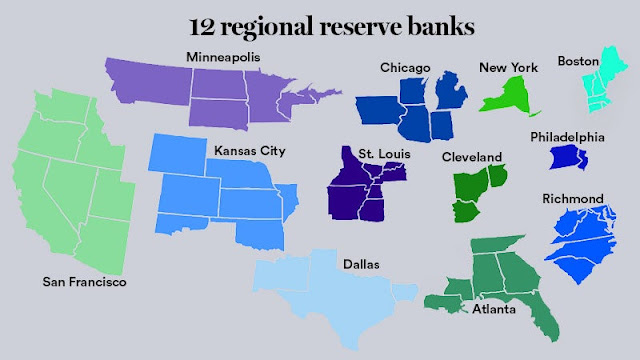Why In News?
This week the Federal Reserve’s board indicated that it may raise interest rates by late 2023 and look at shrinking its balance sheet to adjust to changing economic conditions.
Driven by consumer spending, the annualized growth of the world’s largest economy this year is expected to be a robust 6.4%. Simultaneously, inflation has soared to 5% in May, way above the Federal Reserve’s target of 2%.
To curb the Inflation Fed may increase the rate which will have impact all over the World. Lets Understand Why US Fed's Rate Matter in this Article.
What is Federal Reserve System?
The Federal Reserve System, often referred to as the Federal Reserve or simply "the Fed," is the central bank of the United States.
It includes three key entities: the Board of Governors, 12 Federal Reserve Banks, and the Federal Open Market Committee.
Its key functions include banking system regulation, managing money supply, implementing monetary policy measures, stabilizing price levels and maximizing employment.
The monetary policymaking body FOMC is constituted by the board of governors and five federal reserve bank presidents out twelve on a rotating basis, and meets eight times in a year to deliberate and decide on monetary policy and interest rates.
Why US Fed Rate Matters?
Given that India is a growing economy offering higher returns, there exists a strong link between changes in Fed rate and FII flows.
A good chunk of the world’s wealthiest investors and institutions have their home in the US. They are therefore constantly comparing interest rates outside the US, to those in their home country, to make their allocation decisions.
Impact on Indian Rupee
- Indian Rupee will depreciate if US fed will raise the interest rate. US interest rate hike will be an indication that US economy is in good shape. Thus foreign investors in Indian markets will withdraw their money and invest in US market.
- When they invest in India they buy Rupees in foreign exchange from RBI and when they sell their investment they get dollar against rupee. So when they invest in India demand of Rupees increase which appreciates the rupee and when they sell the demand for dollar increase ultimately leaving Rupee to depreciate against Dollar and Impacting Foreign Reserve.
Impact on Indian equity market
The foreign investors who have invested in Indian market will fear that the depreciation in Indian Rupee will wipe out their profits. Thus, they will start booking profits.
- For example, let’s say an investor invested USD 1,00,000 a year ago in India when the exchange rate is Rs. 71 per US Dollar; in Indian Rupee he invested Rs 71,00,000. In one year, he made 10% return and his portfolio rose to Rs 78,10,000. After US interest rate hike, let say Indian Rupee depreciated to Rs 79 per US Dollar; his portfolio in US Dollar will dip to USD 97,246.38 and he will incur a loss of USD 2,753.62. Thus, he will prefer to book profits, which will further depreciate the rupee as the demand of Dollar Increase.
Impact on Balance of Trade
The dollar is the default reserve and trading currency of the world. This too makes US interest rates an important factor deciding the direction of global trade and investment flows.
- For Example: Being a trading currency for Import and Export it will have direct impact, let's Suppose currently $1 = Rs.70 but due to increase in demand of Dollar rupee depreciates and $1 becomes equal to Rs.75, in this case the cost of import will increase as India will be paying Five More for same goods against a Dollar, and with crude oil being the largest component of Indian imports, it could lead to increased fuel prices, worsening the cost-push inflation.
- Higher Import Cost will increase the Balance of Trade Deficit and Current Account Deficit.
Impact on Indian Debt Market
- There is a huge difference in interest rate in India and US. The policy rate is India is 4.00% while in the US it is 0.25%. Theoretically, an investor can borrow money from the US at 0.25% and invest in India for 4.00%. Thus, he will earn 3.75% return after paying back the borrowed money. The subsequent interest rate hikes by US Fed will reduce this gap and foreign investors will show reluctance to invest in India since the risk-reward will become less favorable. This is in addition to lower returns due to depreciation of the rupee.




